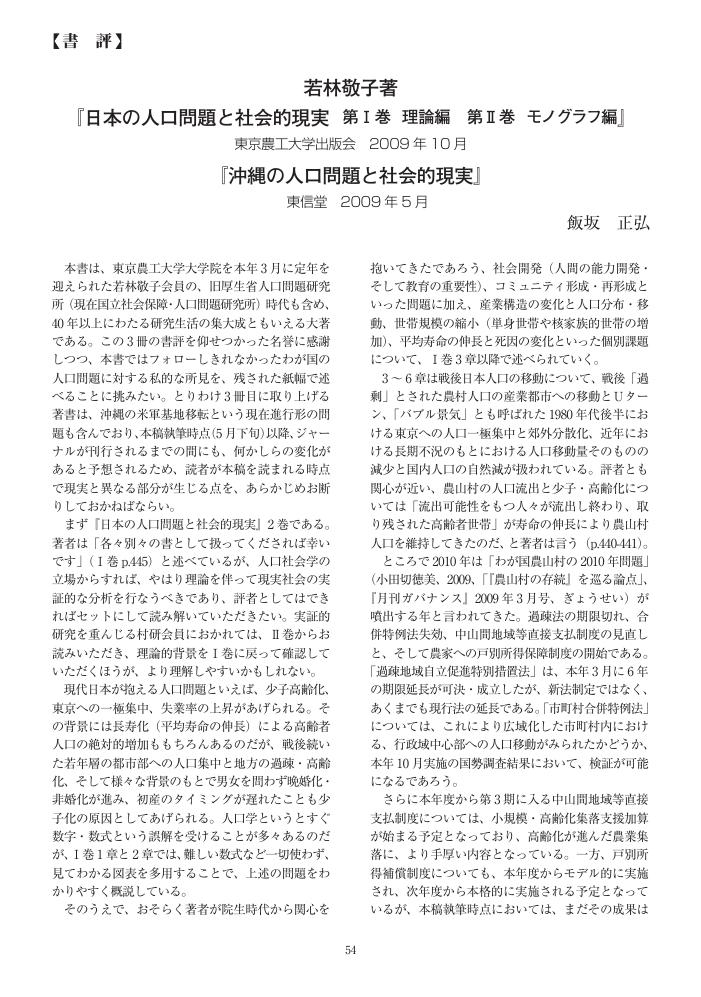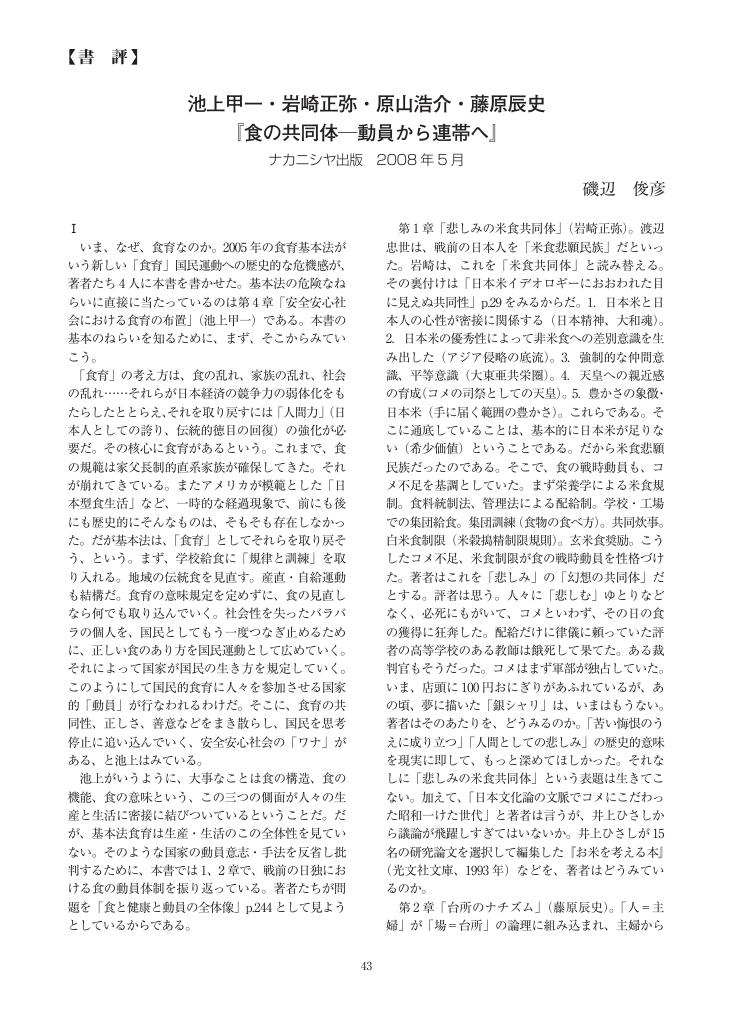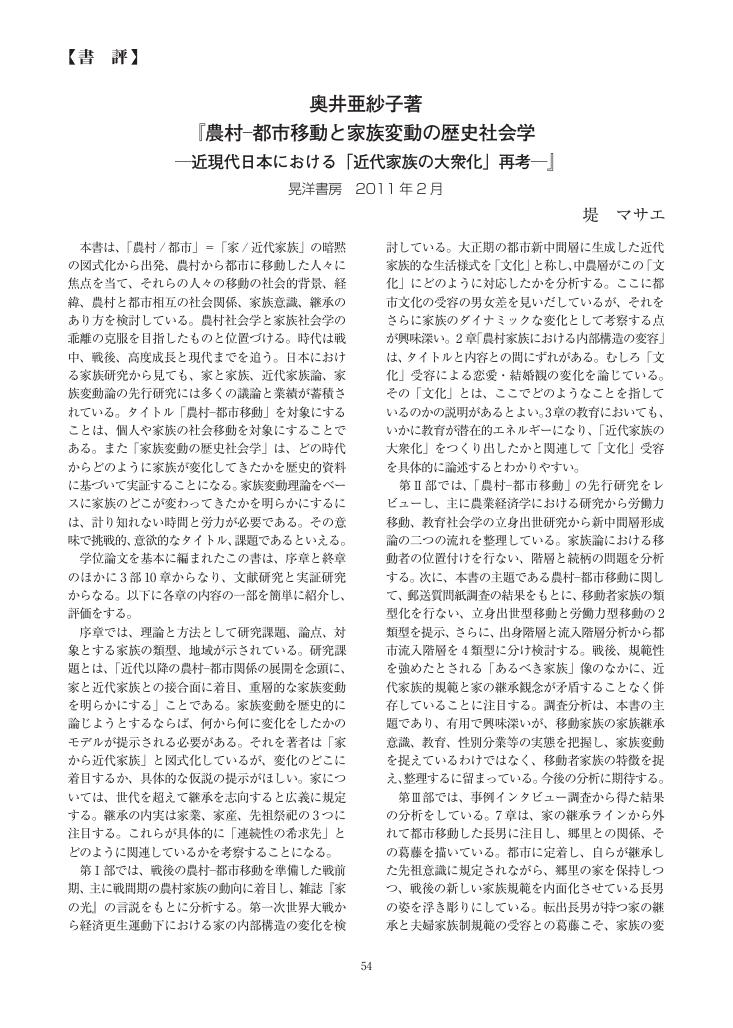1 0 0 0 OA 公共空間としての入会地―イギリスの経験―
- 著者
- 岩本 純明
- 出版者
- 日本村落研究学会
- 雑誌
- 村落社会研究 (ISSN:13408240)
- 巻号頁・発行日
- vol.5, no.1, pp.9-20, 1998 (Released:2013-05-22)
- 参考文献数
- 23
- 被引用文献数
- 2
It is generally recognized that commons have played a key role in English village life.Three types of rights ― such as ownership, common right and public rights of access ―overlap each other on the same lands. After the mid-nineteenth century a social movement led by the urban middle class has been developed claiming public rights of access to the common lands for air and exercise. This paper analyzes the historical process and the significance of the movement. The Commons Preservation Society (now The Open Spaces Society) has been tackling access issues persistently over a century. The Society aimed at not only the protection of common rights from enclosure but the opening of commons for the public enjoyment. The aim was partially realized after a series of Commons Acts in the late nineteenth and early twentieth century. The Metropolitan Commons Act 1866 was the first step in protecting urban commons from enclosure and claimed their preservation as open spaces. The Law of Property Act 1925 established the public rights of access to metropolitan commons for the first time. The Act strictly forbade owners to erect any building or fence whereby access was prevented or impeded. The public now have access rights to areas amounting to about 20 per cent of the whole common lands. The author regards it epoch-making that the general right of public access has been established on a wide range of open country in Britain. Through this process the legal structure of commons has changed its individual characteristic and accepted the concept of the right of access by public at large.
1 0 0 0 OA 樺太植民地農政の中の近代天皇制
- 著者
- 中山 大将
- 出版者
- 日本村落研究学会
- 雑誌
- 村落社会研究ジャーナル (ISSN:18824560)
- 巻号頁・発行日
- vol.16, no.1, pp.1-12, 2009 (Released:2012-12-24)
- 参考文献数
- 58
- 被引用文献数
- 1 2
The imperial Constitution of Japan was established in 1889 and this meant that the modern Japanese imperial institution was also established. The imperial institution in this updated form remained influential throughout the Japanese Empire. In 1928, the Showa Emperor succeeded to the throne and a series of the ceremonies were held to recognize the transition called “Showa-no-Tairei.” Concurrently, in the imperial colony of “Karafuto,” the exemplary farmer campaign was launched by the colonial government of Karafuto. First, this study clarifies the facts on how the colonial agricultural administration of Karafuto utilized the modern imperial institution through the exemplary farmer campaign for its own particular aims. Second, this study discusses the logic for the linkage between Karafuto farmers and the Emperor within the campaign. The colonial government needed to use imperial ideology to make farmers of Karafuto adopt the ideal farming style it had planned, which differed from that of mainland Japan. The colonial government exposed the farmers to Imperial linkages via the ceremony of “Showa-no-Tairei,” in which the farmers were honored, and attempted to legitimize these linkages through the campaign. The logic behind these steps depended on three facts. First, the Showa Emperor toured Karafuto and granted an audience with some of the exemplary farmers when he was the prince. Second, he planted rice on a paddy field in the palace after the demise the Taisho Emperor. Third he made honorable recognition of some of the farmers and used and ate crops dedicated by the farmers at the ceremony of accession, “Showa-no-Tairei.” The colonial government hoped that the farmers and agriculture of Karafuto would become linked with the Emperor and the Empire itself by these facts, and that this linkage would familiarize farmers with an ideology of hard work in order to attain the farming style planned by the colonial government.
- 著者
- 黒柳 晴夫
- 出版者
- 日本村落研究学会
- 雑誌
- 村落社会研究 (ISSN:13408240)
- 巻号頁・発行日
- vol.9, no.1, pp.60-61, 2002
1 0 0 0 OA 農業の技術移転に関する研究
- 著者
- 鈴木 俊
- 出版者
- 日本村落研究学会
- 雑誌
- 村落社会研究 (ISSN:13408240)
- 巻号頁・発行日
- vol.4, no.1, pp.21-32, 1997 (Released:2013-04-12)
- 参考文献数
- 18
The paddy rice production in Heilongjiang Province recorded only 0.8million tons with the area of some 0.21 million ha. in 1980, but increased up to 4.24 million tons with 0.74 million ha. in 1993. There are several reasons for this increment, but the most salient one could be due to “the introduction of paddy nursery technique in upland bed” which was developed in Japan. Further more this technique was also extended to Jilin and Liaoning Province after 6 years of its first introduction, and this changed these provinces from millet and milo production to paddy rice producing areas. Moreover, the Federal Government had started to disseminate this technique to 3 major areas of Northern China since 1990, and has been getting good result. But these brilliant successes of this technology transfer is known among a very few people in Japan. This paper attempts to clarify the structure and method of the technology transfer. This study was carried out by visiting Hokkaido to make interview with the person who has been working for this technology transfer, and also to Heilongjiang Province. The study examined the following items:(1) contents and characteristics of the technique transferred, (2) the structure and method of primary/international transfer, (3) outline of Heilongjiang Province agriculture with reference to paddy production, (4) the structure and method of secondary/domestic transfer. After analyzing various data, the author clarified the structure, method and route of the transfer, and also problems and issues of the technology transfer system in Heilongjiang Province. It is considered that the result of this study will be able to contribute to improve the structure and methods of technology transfer in some other areas of China or developing countries.
1 0 0 0 地域資源管理に関する歴史研究の展望
- 著者
- 伊丹 一浩
- 出版者
- 日本村落研究学会
- 雑誌
- 村落社会研究ジャーナル
- 巻号頁・発行日
- vol.23, no.2, pp.45-46, 2017
1 0 0 0 OA 割地制度とコモンズ
- 著者
- 佐藤 康行
- 出版者
- 日本村落研究学会
- 雑誌
- 村落社会研究ジャーナル (ISSN:18824560)
- 巻号頁・発行日
- vol.17, no.1, pp.23-35, 2010 (Released:2013-01-26)
- 参考文献数
- 65
This article considers contemporary conditions of warichi in both irrigation and forests in Nishikanbara-gun, Niigata prefecture, from the perspective of the commons. The warichi , allegedly established in early modern Japan, is a redistribution system of arable land and forest to share risks associated with natural disasters and to pay land taxes proportionally among landholders in each village. Therefore, the warichi is a corporate form of landholdings. This article presents research from the contemporary conditions of warichi in two cases. I found that the warichi formally remains in the mountain forest, while it has been eliminated in the cultivated land holdings. Considering the landholders’ managing irrigation systems today, warichi could be called a commons. The mountain forest can be said to continue to be commons in that ordinary people can access the areas and enjoy climbing the mountain. Furthermore, this research finds that the mountain forest would be better managed by a cooperative network between mountain landholders, local public administration, and volunteer groups.
1 0 0 0 OA 農村社会学研究の個人的回顧
- 著者
- 木下 謙治
- 出版者
- 日本村落研究学会
- 雑誌
- 村落社会研究 (ISSN:13408240)
- 巻号頁・発行日
- vol.12, no.2, pp.1-6, 2006 (Released:2013-11-02)
- 参考文献数
- 21
My research career consists of four stages. In the first stage (about from 1953 to 1970),my main interest of the research had been placed on theoritical studies of Japanese village community (Mura). At the second stage (about from 1970 to 1985), under the influences of drastic change of rural society and its effect on rural sociology, I gradually diverted research interest from rural studies to family sociology. Speaking of rural studies through this time, I mainly engaged in practical surveys of rural problems. Interest of the studies in the third and fourth stages are almost same direction with second stage. If adding something another through these stages, rural community as an ideal or purposive concept has been becoming one of important perspectives of my rural studies.
1 0 0 0 OA 沖縄の泉水施設の変遷とムラの戦略
- 著者
- 鳥越 皓之
- 出版者
- 日本村落研究学会
- 雑誌
- 村落社会研究ジャーナル (ISSN:18824560)
- 巻号頁・発行日
- vol.17, no.1, pp.1-10, 2010 (Released:2013-01-26)
- 参考文献数
- 15
- 被引用文献数
- 2
This paper aims to explore the reasons behind the appearance of unattractive and formalized parks in rural Japanese communities, especially in those wherein community members enthusiastically participate in the planning of the recreation and leisure areas. Traditionally, rural communities in Japan have been characterized by clear boundaries and strong institutions such as Jichikai , having maintained a Gemeinschaft society. In this paper, we analyze the village of Yoza in the southern area of Okinawa’s main island. In 1944, 41% of the villagers were killed during the invasion of the US Army. However, even after losing many community members, these villages have restructured their organizations and have carefully restored and maintained their common buildings and fields during the more than 50 years that have passed since World War II. Usually, parks that have no historical or regional identity and have impersonal atmospheres are planned by the administrative offices of local governments. However, in a few cases, unattractive parks arise even when community members are actively involved in their planning. The Yoza community is such a case. An analysis of the community’s involvement in the planning of park areas revealed two direct reasons, namely, the subsidy system of the central government and the occupation by the Allied Forces, and one fundamental reason, that is, the values of its inhabitants.
1 0 0 0 座談会 村研50年の歩みを振り返って(上)[含 解題]
1 0 0 0 OA 先人の足跡を今に活かす
- 出版者
- 日本村落研究学会
- 雑誌
- 村落社会研究ジャーナル (ISSN:18824560)
- 巻号頁・発行日
- vol.20, no.2, pp.10-38, 2014-04-25 (Released:2015-07-10)
1 0 0 0 OA ベトナムの「自治村落」と農民組織
- 著者
- 岡江 恭史
- 出版者
- 日本村落研究学会
- 雑誌
- 村落社会研究ジャーナル (ISSN:18824560)
- 巻号頁・発行日
- vol.21, no.2, pp.10-22, 2015-04-25 (Released:2016-05-13)
- 参考文献数
- 40
Hitoshi Saito argued that Asian countries except Japan could not develop agricultural cooperatives because their rural societies do not have the inheritance of autonomous community. But, the facts of Vietnam and China are contrary to Saito's theory. Vietnam has not yet developed agricultural cooperatives in spite of the inheritance of autonomous community. On the other hand, China has developed agricultural cooperatives without the inheritance of autonomous community. The purpose of this paper is to examine these facts through comparative research of Japan, China and Vietnam on history and social structure. Japanese autonomous villages have established their integration units and developed cooperative relationship with outside. Chinese villages do not have autonomous function. But, market economy has permeated Chinese rural society over many years, and many Chinese people have personal connections outside their villages. Many Vietnamese people have not personal connections outside their villages. The author concludes that the requirements for development of agricultural cooperatives are strengthening of market economy and the networks beyond each village.
- 著者
- 飯坂 正弘
- 出版者
- 日本村落研究学会
- 雑誌
- 村落社会研究ジャーナル (ISSN:18824560)
- 巻号頁・発行日
- vol.17, no.1, pp.54-57, 2010 (Released:2013-01-26)
1 0 0 0 IR 研究動向 地理学の研究動向--空間論からのアプローチ
- 著者
- 筒井 一伸 今里 悟之
- 出版者
- 日本村落研究学会
- 雑誌
- 村落社会研究 (ISSN:13408240)
- 巻号頁・発行日
- no.42, pp.301-317, 2006-10
1 0 0 0 OA 池上甲一・岩崎正弥・原山浩介・藤原辰史『食の共同体―動員から連帯へ』
- 著者
- 磯辺 俊彦
- 出版者
- 日本村落研究学会
- 雑誌
- 村落社会研究ジャーナル (ISSN:18824560)
- 巻号頁・発行日
- vol.17, no.2, pp.43-44, 2011 (Released:2013-04-20)
- 被引用文献数
- 1
1 0 0 0 OA 生存機構としての村落社会
- 著者
- 名本 光男
- 出版者
- 日本村落研究学会
- 雑誌
- 村落社会研究 (ISSN:13408240)
- 巻号頁・発行日
- vol.2, no.2, pp.8-18, 1996 (Released:2013-03-12)
- 参考文献数
- 28
This study discusses various survival strategies adopted by a village in a newly reclaimed rice field area of Tsugaru in northern Japan, where the farmers have long suffered from crop failure and famine. The way social relationships between individuals and between groups in the village functioned in various survival strategies are diachronically examined. A swamp along the lower Iwaki river was developed extensively in the Edo era by the Tsugaru-han (the feudal clan) to make new rice fields. Because of low productivity and unstable harvest in the newly reclaimed rice fields, Shinden-byakusho, the immigrant farmers who settled in the region,had to support themselves by working away from home. Such subsistence can be named as “sally type” or “base type”. Even such lifeway was, however, destroyed by frequent crop failure and famine. After each famine, new villages were reestablished by new immigrant farmers. With this historical background, the social relationships between villagers are voluntary and flexible. They are an accumulation of lateral social connections, rather than a stratified vertical relationship. Such social groups have supported the “sally” or “base” type life of the rural society, which relies on one-crop agriculture and cash income by labor away from the village. These groups function in adjusting the social relationships in the village, while their flexible nature allow people to escape the village when necessary.
- 著者
- 堤 マサエ
- 出版者
- 日本村落研究学会
- 雑誌
- 村落社会研究ジャーナル (ISSN:18824560)
- 巻号頁・発行日
- vol.19, no.1, pp.54-55, 2012-10-25 (Released:2014-11-04)
- 著者
- 飯塚 里恵子
- 出版者
- 日本村落研究学会
- 雑誌
- 村落社会研究ジャーナル (ISSN:18824560)
- 巻号頁・発行日
- vol.14, no.2, pp.56-57, 2008 (Released:2012-11-19)
1 0 0 0 OA 埼玉県比企郡小川町における有機農業の展開過程
- 著者
- 小口 広太
- 出版者
- 日本村落研究学会
- 雑誌
- 村落社会研究ジャーナル (ISSN:18824560)
- 巻号頁・発行日
- vol.18, no.2, pp.36-43, 2012 (Released:2014-05-10)
- 参考文献数
- 12
- 被引用文献数
- 3
The purpose of this study is to analyze the regional relationship and the development process of organic agriculture in Ogawa-Town, one of the pioneering areas of organic agriculture in Japan. Organic agriculture in Ogawa-Town was started in the beginning of 1970s by a local farmer named ‘K’. Being engaged in his farming, ‘K’ made direct contact with several consumers and local food enterprises in order to supply his products, and accepted people willing to begin organic farming as trainees on his farm, some of them later started organic farming as independent farmers. Since the late 1980s the number of such newcomers in organic agriculture has gradually increased also in Ogawa-Town, while local farmers except for ‘K’ still continued conventional farming. It was in 2001 that one local farmer named ‘A’ changed his way of farming from ‘conventional’ to ‘organic’, partly because of his aging and increase of abandoned farm land. Conclusively, the development process of organic agriculture in Ogawa-Town is quite characteristic in the sense that organic farming gradually extended in the town, caused by social change surrounding agriculture rather than by social movement of farmers’group.




